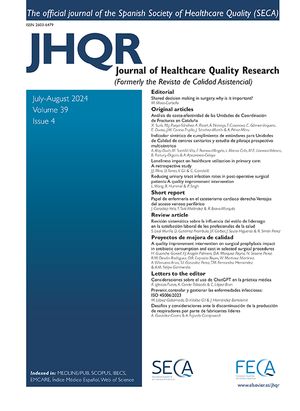La reciente publicación de un informe sobre los mejores hospitales españoles, y su importante repercusión mediática, ha renovado el debate sobre la utilidad de los indicadores de eficiencia y calidad hospitalaria basados en el Conjunto Mínimo de Datos Básicos (CMBD) y sobre las clasificaciones de mejores y peores hospitales a partir de estos indicadores.
Material y métodoRevisión narrativa de los marcos conceptuales para el ajuste por gravedad y comparación de hospitales a partir de bases de datos clínico-administrativas, de las limitaciones de los sistemas y de las fuentes de datos, concretando ocasionalmente en la clasificación top-20.
ResultadosLa comparación de resultados hospitalarios requiere un marco conceptual sólido que tenga en cuenta la elección de resultados claramente indicativos de mejor o peor calidad, la elección de variables de ajuste adecuadas, una cuidada metodología estadística y una presentación de los resultados informativa, así como tener en cuenta las limitaciones de los sistemas de información tipo CMBD. Los top 20 incumplen algunos de estos supuestos haciendo dudosa la clasificación de hospitales elaborada.
ConclusionesLa comparación de resultados hospitalarios es una necesidad para la mejora de la calidad hospitalaria; para cumplir este objetivo deben mejorarse los métodos actualmente utilizados.
The recent publication of a report on the best Spanish hospitals, and their important repercussion in the media, has updated the debate about the usefulness of indicators of efficiency and hospital quality obtained from the Minimum Basic Data Set (MBDS). These indicators might let us classify better and worse hospitals in our setting.
Material and methodsA narrative description of the framework for risk adjustment and hospital comparison from administrative databases has been included. System and sources of data limitations have been considered, summing up occasionally in the classification top-20.
ResultsThe comparison of hospital outcomes needs a solid conceptual framework that keeps in mind the selection of outcomes that clearly indicate of better or worse quality. The election of adequate adjustment variables, statistical methodology and an informative presentation of the results, keeping in mind the limitations of the information systems as CMBD have been analyzed. The top 20 has some limitations that make doubtful the hospitals’ classification.
ConclusionsThe comparison of hospital outcomes is a useful tool for the improvement of hospital quality, but to complete this objective the methodology ought to be improved.






